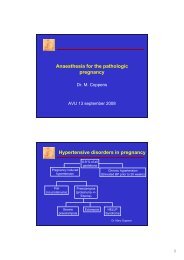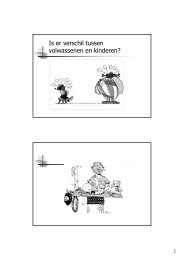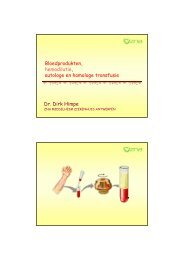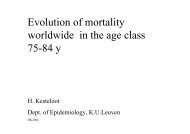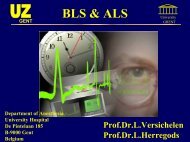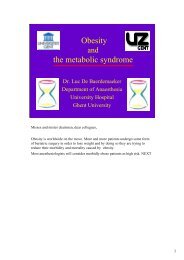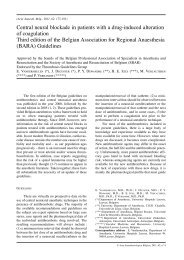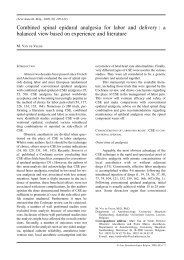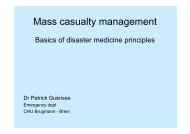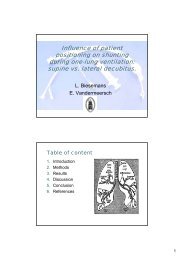Chronic Pain: Fundamental concepts and clinical syndromes
Chronic Pain: Fundamental concepts and clinical syndromes
Chronic Pain: Fundamental concepts and clinical syndromes
Create successful ePaper yourself
Turn your PDF publications into a flip-book with our unique Google optimized e-Paper software.
Difference acute vs. chronic pain<br />
Guy Hans<br />
Multidisciplinary <strong>Pain</strong> Center<br />
Antwerp University Hospital<br />
<strong>Chronic</strong> <strong>Pain</strong>:<br />
<strong>Fundamental</strong> <strong>concepts</strong><br />
<strong>and</strong> <strong>clinical</strong> <strong>syndromes</strong><br />
• Acute <strong>Pain</strong><br />
• Short duration<br />
• Preventive function<br />
• Protecting the body<br />
against lesioning<br />
• Presence of lesion<br />
• Wound<br />
• Burn injury<br />
• Fracture<br />
• ...<br />
• <strong>Chronic</strong> <strong>Pain</strong><br />
• Long duration<br />
• > 6 months<br />
• No preventive function<br />
• No protection against<br />
lesioning<br />
• Often no anatomical lesion<br />
to be identified<br />
• Temporary dysfunction?<br />
The Process of <strong>Pain</strong>: From Acute<br />
to <strong>Chronic</strong> Low Back <strong>Pain</strong><br />
From <strong>Chronic</strong> <strong>Pain</strong> to <strong>Chronic</strong><br />
<strong>Pain</strong> Syndrome<br />
20%<br />
<strong>Chronic</strong><br />
3-4<br />
months<br />
3-4<br />
Months<br />
1<br />
month<br />
20%<br />
10%<br />
<strong>Chronic</strong><br />
2<br />
weeks<br />
2<br />
weeks<br />
50%<br />
• Fortunately, most individuals<br />
recover from episodes of acute<br />
LBP (Deyo, 1983).<br />
• 50% in 2 weeks, 70% by 1<br />
month, 90% by 3-4 months.<br />
(Mayer & Gatchel, 1988).<br />
• Unfortunately, beyond 3-4<br />
months (now meeting the<br />
<strong>Chronic</strong> definition), full recovery<br />
is unlikely for the remaining<br />
10%.<br />
<strong>Chronic</strong><br />
<strong>Pain</strong> Syndrome<br />
<strong>Chronic</strong> <strong>Pain</strong><br />
• 75% of the 10% (or more) of<br />
individuals who develop chronic<br />
pain lead relatively normal lives,<br />
although they may not return to<br />
full-time employment.<br />
• About 25% of those with chronic<br />
pain develop <strong>Chronic</strong> <strong>Pain</strong><br />
Syndromes (Klapow et al.,<br />
1993).<br />
Comparison of <strong>Chronic</strong> <strong>Pain</strong> <strong>and</strong><br />
<strong>Chronic</strong> <strong>Pain</strong> Syndromes<br />
<strong>Pain</strong> Components CP CPS<br />
Nerve involvement strong varies<br />
<strong>Pain</strong> varies varies<br />
Suffering varies intense<br />
<strong>Pain</strong> Behavior limited strong<br />
____________________________________________<br />
CP=<strong>Chronic</strong> <strong>Pain</strong> CPS= <strong>Chronic</strong> <strong>Pain</strong> Syndrome<br />
1
CHRONIC PAIN SYNDROME<br />
SYMPTOMS<br />
How <strong>Chronic</strong> <strong>Pain</strong> Syndromes<br />
Develop: The <strong>Chronic</strong> <strong>Pain</strong> Cycle<br />
• Reduced activity<br />
• Impaired sleep<br />
• Depression<br />
• Suicidal ideation<br />
• Social withdrawal<br />
• Irritability <strong>and</strong> Fatigue<br />
• Strong somatic focus<br />
• Memory <strong>and</strong> cognitive<br />
impairment<br />
• Misbehavior by children in the<br />
home<br />
• Less interest in sex<br />
• Relationship problems<br />
• <strong>Pain</strong> behaviors<br />
• Helplessness<br />
• Hopelessness<br />
• Alcohol abuse<br />
• Medication abuse<br />
• Guilt<br />
• Anxiety<br />
• Poor self-esteem<br />
• Loss of employment<br />
• Kinesiophobia<br />
<br />
<br />
<br />
• This is the typical cycle that<br />
individuals with chronic pain<br />
<strong>syndromes</strong> experience. Efforts to<br />
minimize pain by reducing<br />
activity work only for the short<br />
term. Over time, the lowered<br />
activity results in reductions in<br />
muscle strength, general<br />
deconditioning, <strong>and</strong><br />
INCREASED pain.<br />
<strong>Chronic</strong> <strong>Pain</strong> Syndromes:<br />
Typical Treatment Progression<br />
Identify presence of a chronic noncancer pain problem<br />
Specialty Medical Interventions (i.e., surgery, blocks, meds)<br />
IMPROVED<br />
Return to Primary Care<br />
Ambulatory Care Clinic<br />
UNIMPROVED<br />
Refer to Multidisciplinary<br />
<strong>Pain</strong> Clinic or Program<br />
• Typically, patients with<br />
persistent chronic pain are<br />
referred to specialists for<br />
treatment.<br />
• Some (those with chronic<br />
pain <strong>syndromes</strong> included) do<br />
not improve, <strong>and</strong> eventually<br />
may be referred to<br />
multidisciplinary clinics or<br />
programs where they are<br />
more likely to benefit.<br />
• Unfortunately, this results in<br />
delayed access, increased<br />
costs, <strong>and</strong> patient frustration.<br />
<strong>Chronic</strong> <strong>Pain</strong> Syndromes:<br />
Alternative Treatment Strategy<br />
Identify presence of a chronic noncancer pain problem<br />
Identify presence or absence of a chronic pain syndrome<br />
Syndrome Present<br />
Refer to Multidisciplinary <strong>Pain</strong> Clinic<br />
or Program for Evaluation<br />
Ambulatory Care Clinic<br />
Specialty Medical Evaluations <strong>and</strong><br />
Treatments (i.e., surgery, blocks, meds)<br />
UNIMPROVED<br />
Refer to Multidisciplinary<br />
<strong>Pain</strong> Clinic or Program<br />
Syndrome absent<br />
IMPROVED<br />
Return to Primary Care<br />
• In this alternative model,<br />
identification of a chronic pain<br />
syndrome occurs much earlier<br />
in the process.<br />
• Early identification would lead to<br />
more timely multi-disciplinary<br />
intervention, improved patient<br />
satisfaction, medical cost<br />
savings, <strong>and</strong>, for some,<br />
improved outcomes.<br />
ALGORITHM FOR CHRONIC PAIN<br />
Core questions !<br />
Negative Neurological<br />
Deficits<br />
Conservative Treatment<br />
(bedrest, NSAIDS, traction, etc.)<br />
Not better<br />
ANESTHESIOLGY<br />
(Nerve blocks for RSD, neuropathic pain,<br />
trigger points, neuromas, radiculopathy,<br />
complex acute pain problems, etc.)<br />
NOTES:<br />
*Send to Neurology if headache or TMJ. Send<br />
to Neurology or Oncology if cancer pain.<br />
CHRONIC PAIN PATIENTS<br />
(persistent pain > 6 months)<br />
PM&RS<br />
(Physical modalities)<br />
PSYCHOLOGY<br />
(evaluation, coping skills training,<br />
biofeedback, relaxation, etc.)<br />
Conservative Treatment<br />
(rest, NSAIDS, traction, etc.)<br />
Positive Neurological<br />
Deficits<br />
•Motor weakness<br />
•Objective sensory (dermatomal)<br />
•Bowel/Bladder dysfunction<br />
•Must be new pain if + for<br />
previous surgery<br />
MRI <strong>and</strong> NEUROLOGY *<br />
Not better<br />
NEUROSURGERY<br />
Consult to CHRONIC PAIN CLINICS<br />
• What is the type or category of pain?<br />
• Is there a primary cause of pain?<br />
• What additional factors are contributing to the pain?<br />
• Are treatments available for the primary cause of the<br />
pain?<br />
• Are treatments available for additional factors which<br />
contribute to the pain?<br />
• Are there other medical or psychosocial conditions<br />
that should influence the choice of treatment?<br />
2
<strong>Pain</strong> evaluation<br />
Types of <strong>Pain</strong><br />
Neuropathic<br />
<strong>Pain</strong><br />
•Peripheral<br />
•Central<br />
•Dysesthesia<br />
•Paresthesia<br />
•Allodynia<br />
•Hyperalgesia<br />
•Hyperpathia<br />
•Wind-up<br />
<strong>Pain</strong> Characteristics<br />
Spontaneous<br />
<strong>Pain</strong><br />
Evoked<br />
<strong>Pain</strong><br />
Sensory<br />
Disturbances<br />
Patient Characteristics<br />
Nociceptive<br />
<strong>Pain</strong><br />
•Somatic <strong>Pain</strong><br />
•Muscle<br />
•Bone<br />
•Visceral <strong>Pain</strong><br />
•Superficial<br />
•Deep<br />
• Visceral pain<br />
• Internal organs<br />
• Somatic pain<br />
• Superficial<br />
• Deep<br />
• Neuropathic pain<br />
• Central<br />
• Peripheral<br />
• Mixed pain<br />
• (psychogenic pain)<br />
Lower Back <strong>Pain</strong><br />
• $20B annually in direct health care costs 1<br />
Some Common <strong>Pain</strong> Conditions<br />
• 5 th most common reason for MD visit 1<br />
1 Rives & Douglass, J Am Board Fam Pract 2004;17:S23–31.<br />
Complex Regional <strong>Pain</strong> Syndrome<br />
CRPS - Continued<br />
• Approximately 10% of patients referred to pain clinics have CRPS<br />
• Includes reflex sympathetic dystrophy (CRPS 1) <strong>and</strong> causalgia<br />
(CRPS 2)<br />
• includes burning pain, hypersensitivity, allodynia, edema, <strong>and</strong>,<br />
sometimes, muscle spasms <strong>and</strong> dystonias<br />
• Sympathetically maintained pain - The pain is accompanied<br />
by signs of autonomic dysfunction, <strong>and</strong> sympathetic blockade<br />
generally relieves pain.<br />
• Sympathetically independent pain - the pain state that occurs<br />
most often in treatment-resistant cases of CRPS, in which<br />
sympathetic blockade or sympathectomy yields no <strong>clinical</strong><br />
reduction in pain.<br />
• CRPS 1<br />
• An initiating noxious event, however trivial,<br />
• Ongoing pain, allodynia, or hyperalgesia that is not limited to the<br />
distribution of a single peripheral nerve <strong>and</strong> is disproportionate to the<br />
inciting event, <strong>and</strong><br />
• Evidence of edema, blood-flow abnormalities (such as mottled skin), or<br />
abnormal sudomotor activity in the region of pain (such as sweaty<br />
skin).<br />
• CRPS 2<br />
• Development after a nerve injury,<br />
• Ongoing pain, allodynia, or hyperalgesia that usually exceed the<br />
distribution of the injured nerve, <strong>and</strong><br />
• Evidence of edema (figure 1), skin blood-flow abnormalities, or<br />
abnormal sudomotor activity in the region of pain (as in CRPS 1).<br />
Hayek & Mekhail, The Physician <strong>and</strong> Sports Medicine:<br />
VOL 32 - NO. 5 - MAY 2004<br />
3
Neuropathic <strong>Pain</strong><br />
• 4M People in the US/year suffer from Neuropathic pain (NP),<br />
caused by a primary lesion or dysfunction in the nervous<br />
system 1<br />
• Associated with diabetic peripheral neuropathy, postherpetic<br />
neuralgia, human immunodeficiency<br />
virus-related disorders, <strong>and</strong> chronic radiculopathy.<br />
• Treatment often fails because 2 :<br />
• inadequate diagnosis <strong>and</strong> a lack of appreciation of the<br />
mechanisms involved<br />
• insufficient management of comorbid conditions<br />
• incorrect underst<strong>and</strong>ing or selection of treatment options<br />
• the use of inappropriate outcomes measures<br />
Thank you !<br />
1 Mayo Clin Proc. 2004 Dec;79(12):1533-45.<br />
2 J <strong>Pain</strong> Symptom Manage. 2003 May;25(5 Suppl):S12-7<br />
4



